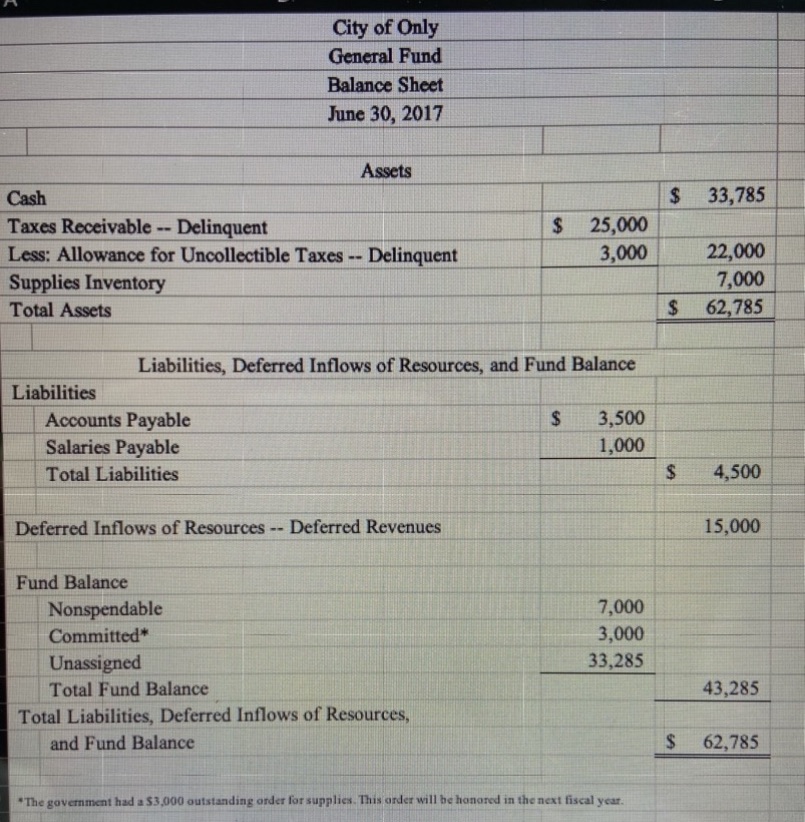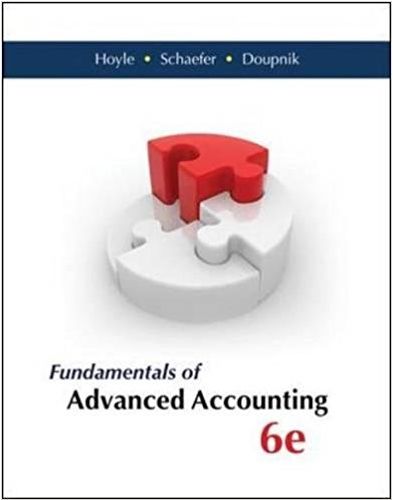Question
The City Council passed the budget for Fiscal Year 2018. The finance director estimates revenues for the year at $130,000, and the program managers plan
The City Council passed the budget for Fiscal Year 2018. The finance director estimates revenues for the year at $130,000, and the program managers plan to spend $125,000. When recording the budget, use only the general ledger control accounts.
Original budget
Revenues
Property Taxes88,400
Sales Taxes31,200
Intergovernmental 10,400
Total Revenues 130,000
Expenditures
Operating
General Government43,500
Public Safety 25,000
Streets and Roads 31,000
Culture and Recreation 12,000
Sanitation and Health12,000
Capital Outlay?
Total Expenditures 123,500
Excess (Deficiency) of Revenues6,500
Over (Under) Expenditures
Other Financing Sources (Uses)
Transfer to EF (1,500)
Total Other Financing Sources (Uses) 5,000
Change in Fund Balance
Fund Balance, July 1, 2017 43,285
Fund Balance, June 30, 201848,285
2The finance director re-established encumbrances (see the prior year balance sheet) that were outstanding at the end of the previous year.
3The deferred revenue account, which represents property taxes not earned in the previous year, was reversed.
4The City Council levied the property taxes for the year, $90,000. Based on prior experience, 8% of the levy should prove uncollectible. Also, half the levy should be paid within the discount period, for which the taxpayers receive a 2% discount.
5Program managers for the City ordered $20,000 in supplies. The city uses the purchases method to account for its inventory.
6The City received an unexpected grant of $15,000 from the State to pay for public safety activities. The cash was received.
7The City Council increased the budget for capital outlay appropriations by $39,000 and increased estimated transfers out to CPF and EF by $10,000 and $1,500, respectively.
8The City ordered two new police cars estimated to cost $19,500 each.
9The City received $30,000 in sales tax revenues.
10The City collected the following property taxes:
Prior year, first 60 days of current year . . . . . . . . . . . . . . . . $7,000
Prior year, after first 60 days of current year . . . . . . . . . . . . 13,000
20,000
11The balance of the previous year's taxes was written off as uncollectible.
12The City received supplies previously ordered (see entries #2 and #5).
EncumbranceActual Cost
General Government 6,4006,300
Public Safety 3,5003,600
Streets and Roads 4,5004,500
Culture and Recreation 1,5501,800
Sanitation and Health 1,5501,800
13Both police cars on order were received (see entry #8). The actual cost was the same as the estimated cost.
14$50,000 of taxes receivable were collected within the discount period.
15Two old police cars were sold at auction, the customary practice for disposing of capital assets that are no longer in use. Each car had originally cost $15,000 and had accumulated depreciation of $12,000. The government received $1,000 for each car.
16The City made the following payments:
Accounts Payable.................................................................... $60,000
Salaries............................................................................. 35,000
Garbage Service (the total bill was $20,000)................15,000
$110,000
Of the total payments, $10,000 qualified under the public safety grant (see entry #6). The balance of the grant will be used in the next fiscal year. Also, unpaid salaries at year-end were $2,500. Finally, the salary payment included $3,000 in compensated absences; $7,000 in compensated absences will be paid in future years.
All expenditures are allocated by function using the following percentages:
GeneralGovernment ............35%
PublicSafety ....................... 20%
StreetsandRoads...................25%
CultureandRecreation ...........10%
SanitationandHealth. .. ........ 10%
17The City collected another $21,000 in taxes receivable during the remainder of the fiscal year. The City expects to collect an additional $2,000 in the first 60 days of the following fiscal year. The balance will be collected or written off later in the next fiscal year.
18Current taxes receivable and the related allowance were reclassified as delinquent after the due date.
19The inventory of supplies at year-end was $8,500.
20The City Council ordered the following payments to other funds:
Special Revenue Fund (to reimburse the SRF for a General Government expenditure that should have been paid from the General Fund) .. $5,000
Capita lProjectsFund(for City's portion of construction project) .....10,000
Debt Service Fund#2(for principal and interest payments on long-term debt) ...................... 11,785
Enterprise Fund (to provide financing for capital projects) ......... 2,500
All of the payments were made except the payment to the Special Revenue Fund. The payment to the SRF will be disbursed in the next fiscal year.
21The City Council ordered that all outstanding orders be honored in the following fiscal year.
22Equipment was transferred from the General Government to the Enterprise Fund. The equipment cost $20,000 and had accumulated depreciation of $9,000.
23The budgetary accounts were closed.
24$2,900 was paid to Debt Service Fund #4 to assist in an advanced refunding of debt.

City of Only General Fund Balance Sheet June 30, 2017 Assets Cash $ 33,785 Taxes Receivable -- Delinquent $ 25,000 Less: Allowance for Uncollectible Taxes -- Delinquent 3,000 22,000 Supplies Inventory 7,000 Total Assets $ 62,785 Liabilities, Deferred Inflows of Resources, and Fund Balance Liabilities Accounts Payable $ 3,500 Salaries Payable 1,000 Total Liabilities $ 4,500 15,000 Deferred Inflows of Resources -- Deferred Revenues Fund Balance Nonspendable Committed* Unassigned Total Fund Balance 7,000 3,000 33,285 43,285 $ 62,785 Total Liabilities, Deferred Inflows of Resources, and Fund Balance *The government had a $3,000 outstanding order for supplies. This order will be honored in the next fiscal year.
Step by Step Solution
There are 3 Steps involved in it
Step: 1

Get Instant Access to Expert-Tailored Solutions
See step-by-step solutions with expert insights and AI powered tools for academic success
Step: 2

Step: 3

Ace Your Homework with AI
Get the answers you need in no time with our AI-driven, step-by-step assistance
Get Started


